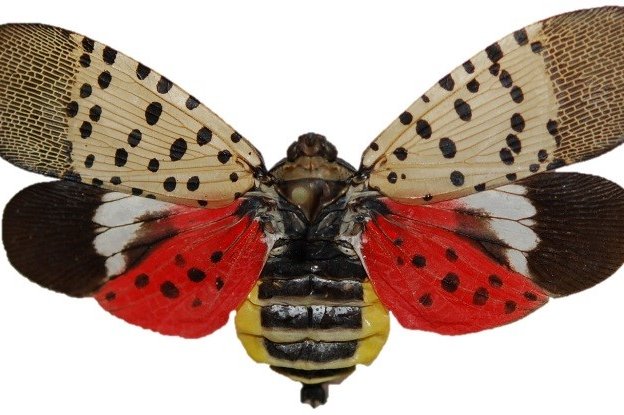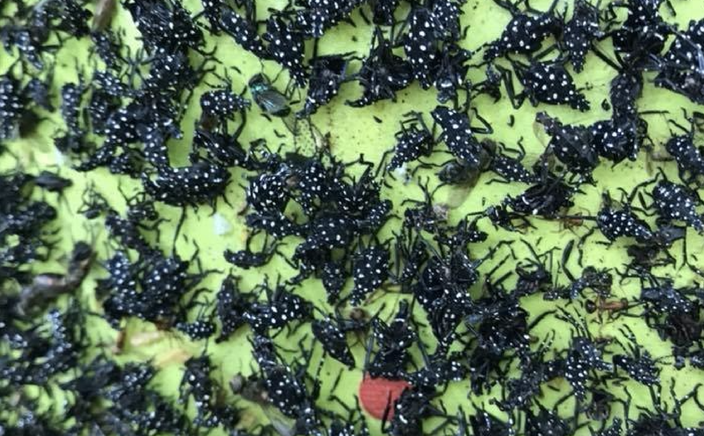
August 31, 2018
 Photo courtesy/Pennsylvania Dept. of Agriculture
Photo courtesy/Pennsylvania Dept. of Agriculture
Since 2014, the spotted lanternfly has spread across 14 counties in Pennsylvania and could cost Pennsylvania's fruit and tree industries more than $18 billion. New research using fungi to attack the pests has scientists 'cautiously optimistic.'
Philadelphia's worst nightmare may be spreading to eat our trees and plants, damage our outdoor furniture and test our futile attempts to mitigate its onslaught.
Multiple reports indicate the the spotted lanternfly is becoming prevalent in various locations in downtown Philly, according to a Facebook post from the Philadelphia Parks and Recreation's Tree Philly program.
Another Reddit user posted a photo of a lanternfly in Center City, prompting commenters to note an infestation in nearby Chester County's French Creek State Park. Others have reported sightings in Radnor as well.
Spotted lanternfly spotted downtown from r/philadelphia
The spotted lanternfly is believed to have arrived in Berks County in 2014, likely on a boat carrying goods from Asia. Officials say the pest, which is native to China, Bangladesh and Vietnam, could potentially be the most destructive invasive species ever to arrive in the United States.
In Philadelphia, the insects were first spotted by officials in late October 2017. The city was placed in a quarantine zone encompassing more than a dozen counties in southeastern Pennsylvania. Their growing presence on city streets is not a good sign.
Spotted lanternflies feed on a variety of plants trees — more than 70 different species — but show a strong preference for Tree of Heaven, grape, cherry, peach, apple, pine, sugar maple and cherry trees. When they attack, they leave visibly darkened "weeping wounds" on tree trunks, exposing sap that attracts other insects to feed. Their egg masses also leave a grey mud that covers various surfaces.
Working with Penn State University, agriculture officials have spent more than $20 million this year on research and eradication efforts, fearing other states will fall prey to a broader U.S. infestation. Colonies have already appeared in New Jersey and northern Virginia.
Pennsylvania residents are going to be a crucial part of the war against spotted lanternflies. Our defenses are elaborate and disgusting – smash them, poison them, vacuum them up. In other words, see a spotted lanternfly, kill a spotted lanternfly.
Environmental officials recommend homeowners take measures to catch the pests by wrapping sticky tape around trees. When the flies crawl up tree trunks, they become stuck in the tape. Some say using essential oils like spearmint or peppermint will help attract them to the traps, but the risk of using sticky tape is that it can also wind up trapping small birds and other beneficial insects.
"If you see egg masses, scrape them off, double bag them and throw them away," says the Pennsylvania Department of Agriculture. "You can also place the eggs into alcohol or hand sanitizer to kill them."
At rest, spotted lanternflies are 1-inch long and 1- to 2 inches wide. Immature nymphs are black with white spots and develop red patches as they grow, as seen below:
Pennsylvanians have been catching the invasive spotted lanternflies with sticky paper wrapped around tree trunks. Immature nymphs of the insect are black with white spots and develop red patches as they grow, as seen above.
If you happen to see a spotted lanternfly in Philadelphia, don't hesitate to kill it—but maybe take a picture first and send it to Badbug@pa.gov.
Follow Michael & PhillyVoice on Twitter @mtanen88 | @thePhillyVoice
Like us on Facebook: PhillyVoice
Add Michael's RSS feed to your feed reader
Have a news tip? Let us know.
 French & Pickering Creeks Conservation Trust/Facebook
French & Pickering Creeks Conservation Trust/Facebook